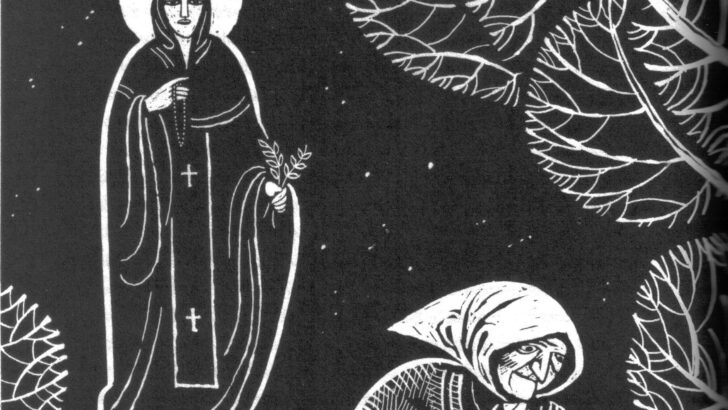The Slavic Myths by Noah Charney and Svetlana Slapšak (Thames and Hudson, £20.00/ €23.50)
The strange world of Slavic myths is usually beyond the imaginative reach of those of us brought up in Western Europe.
However, many years ago now, when I was at college in the USA, I had a regular place I sat at in the main library of the University of Michigan Library. Near at hand were the long row of the volumes of The Mythology of All Races (1916-1932), an enterprise I came to regard as quite an important a cultural landmark, as important as the epochal 11th edition of the Encyclopaedia Britannica.
I was ostensibly studying English literature, anthropology and archaeology. In the odd moments away from my proper work I would read the book devoted to Celtic mythology by J. A. MacCulloch. This shared a volume with the book on Slavic Mythology by the then well known scholar Dr Jan Máchal (1864-1924) of Prague.
Dark secrets
The content had been affected by the exigencies of the international war, which in part the Russian state and Slavic myths were the cause of, just as Teutonic myths and German ambitions were to be the cause of the next world war.
In those decades before the collapse of Communism much was heard of the ‘Pan-Slavic Ideal’ which was prompted from Moscow as a way of providing an underlying unity to an Eastern Europe led by Russia that could be rooted in the very ancient pagan past. Their forms of Christianity, too, have been tainted by those dark secrets of the northern forests.
But that is not the intention of the present authors. They write about myths and legends free from political or social contexts. Nation building, race consciousness, and the great Pan Slavic ideal are not for them, thank goodness. Their focus is on personal psychology rather than race consciousness. But let the author of the essays that accompany the new versions of the stories, Dr Slapšak, explain what their intentions were.
It is intended to offer “an entry point into the complicated world of Slavic myths and their protagonists – a sprawling unwieldy world subject about which only isolated pockets of knowledge survive”. From the beginning of their work they decided the book would not consist purely of academic analysis. Their new versions of some of the great Slavic mythic tales. These, however, are unattributed to original sources which is disappointing.
“Most of all we hope that the book would be a delight to read”. It is not in any way intended to be comprehensive but is merely “a personal selection of Slavic myths, bearing witness to their narrative and performative power and to the variety of interpretations they provoke”.
Her essays, while they will provoke many readers to comment and doubt, are filled with interesting ideas and information which cannot help but provoke interest. There are full notes, and an extensive bibliography which will certainly update my own ideas derived from Jan Máchal.
The ideal reader they have in mind would seem to be young people in their 20s and 30s who already enjoy the world of fantasy fiction and film. It is not a book for younger children, though would be acceptable for later teens, so parents may need to be careful.
My own hope of more Slavic material to compare and contrast with the traditions pagan and Christian in Ireland, is thus largely frustrated. But instead I have encountered some new ideas. But there is nothing here that answers to our texts such as The Book of Invasions or The Colloquy of the Ancients.
Insight
Nor does it provide much insight into the actual religion of the Slavs, that realm of domestic rites, local rituals and tribal creeds, and their interactions with Catholic and Orthodox beliefs, their cultural interactions with the Celts, Vikings and Islamic Ottomans. How did they deal with birth, marriage, harvest home, death, and the creation of their locality? This is a great pity.
In a sense the Pan-Slavism of the political world became a mere vehicle for Russian ambitions to dominate Eastern Europe, ambitions which still exist of course. So a book of this kind is important in illustrating some aspects of the movement, which has really to be seen as an expression of Russian imperialism. Southern Slavs may not see it in quite this frame, especially those of Catholic culture in Slovenia.
I think we have to realise that ancient myths are not merely material for stories to entertain the young, or to stimulate artists. They are a part of the religious, spiritual and philosophical heritage of the world, and have to be treated with respect. So the tales in this book are more akin to the kind of things we know here in Ireland.
But all mythologies are a form of ‘natural revelation’ when taken in context and worthy of respect and study. But this book is intended as the authors admit to be a work of psychological entertainment, not academic enlightenment.
A word on the scraperboard illustrations, which are by a young British graphic worker Joe McLaren, and are intended in their black and white simplicity to the world of woodcuts. His work has been compared to classic images of Reynolds Stone and Edward Bawden. I expect we shall see his work more widely as time passes. They have a strangely intense presence.
Presence
This book, with its dramatic illustrations, will go a long way to enlarging western ideas about Eastern Europe and that would be no bad thing, given the continuing presence in our lives of the brooding Slavic mind of President Putin.
But aside from that the world of Slavic myth has already conquered a part of our western European imaginations through such things as Stravinsky’s creation The Fire Bird (1910), one of the myths which are dealt with in this book. So great things have come from them in the past and will do in the future.


 Peter Costello
Peter Costello
